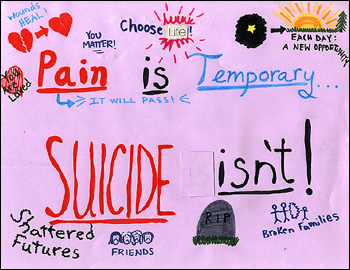Age 17 |
 |
 Emma, Age 17 |
|
Teenagers are at high-risk for suicide if:
|
Warning Signs (Teens who display some or all of these signs, should get help fast!)
|
 "Suicide" by Emma, age 17 |
Helping a Friend If you have a suicidal friend, s/he needs a good friend to help her overcome the pain s/he is in right now, and carry on with her life.
|
If you feel suicidal: We all feel sad and depressed at some point in our lives and this can lead to thoughts of suicide. These thoughts will pass and your pain is only temporary and it will get better. If you are having suicidal thoughts, you should:
|